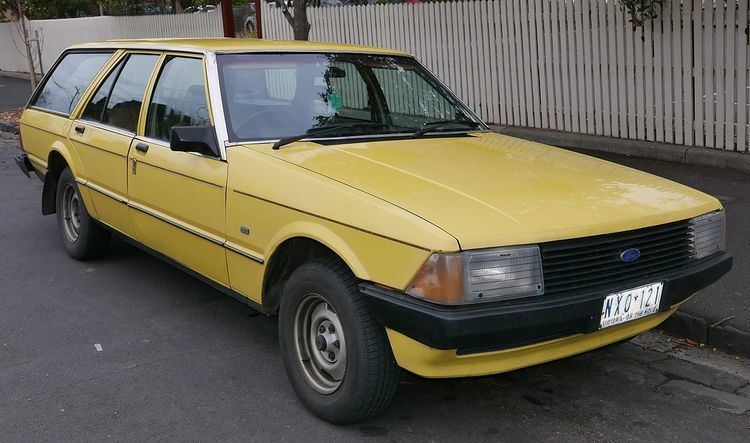Also called Ford Fairmont (XD) Layout FR layout | ||
 | ||
Production March 1979 – March 1982 Body style 4-door sedan5-door station wagon2-door coupé utility2-door panel van | ||
The Ford Falcon (XD) is a full-size car that was produced by Ford Australia from 1979 to 1982. It was the first iteration of the fourth generation of this Australian-made model and also included the Ford Fairmont (XD)—the luxury-oriented version of the Falcon.
Contents
Overview
The Falcon XD was released in March 1979 replacing the Falcon XC. It featured a new smaller body with no reduction in interior space. Stylistically, the XD was strongly influenced by the European Ford Granada Mark II of 1977. The only common components shared between the Granada and the Falcon however were the headlights. Unlike its predecessor, the XD range did not include a 2-door Hardtop model.
The base engine offered in the XD range was a 3.3-litre six cylinder engine. Other choices were a 4.1-litre (250 cu in) six cylinder, a 4.9-litre (302 cu in) eight cylinder and a 5.8-litre (351 cu in) eight cylinder engine. Transmissions available were a three speed column shift manual for six cylinder versions, the popular four speed manual floor shift, and the most popular transmission choice, the three speed automatic with the selector lever located either on the steering column or the floor. All engines had a carburettor with electronic ignition. In June 1980 the 3.3 and 4.1 inline six's iron cylinder head was replaced by an alloy head.
A total of 197,293 XD Falcons were built prior to the XD being replaced by the Falcon XE in March 1982.
Model range
The XD series was initially offered in five models:
Commercial variants of the XD Falcon were released in September 1979 with four models offered:
S Pack option
An "S Pack" option was introduced at launch in March 1979. It included slotted wheels, pinstriping, "S" badging, wool blend cloth trim, digital clock, driving lights, blacked out paint treatments and sports instrumentation which included a tachometer.
European Sports Pack (ESP) option
A European Sports Pack (ESP), noted as option 54, was introduced in June 1980. It was offered as an option on the Falcon GL Sedan, and included "Bathurst" globe alloy wheels, sports suspension with Bilstein shock absorbers, "Scheel" front seats, red lit instrument panel and clock and the 4.1 litre alloy head six cylinder engine. A European Sports Pack was also offered as an option on the Fairmont Ghia from January 1981.
Sundowner van
A Sundowner van was offered with standard equipment as in GL van but also including the 4.1-litre engine, four-speed manual floor shift transmission, slotted steel wheels, sports instrumentation, front and rear spoilers, driving lights and exterior striping.
Motorsport
When Ford Australia pulled out of racing in 1973 designer Wayne Draper saw an opportunity to provide Falcon racing teams with aerodynamic kits. He set up an aftermarket body styling company with Bob McWilliam, but remained a silent partner to avoid conflicts with Ford management. Between 1976 and 1978 they produced front splitters and rear spoilers for XB and XC Falcon Hardtop race cars. Draper, who was a Senior Designer for the XD-XF Falcon, purchased the rights to the "HO" nameplate, as "homologated options". Draper then designed an aero kit and tested scale models of an XD Falcon in Ford's wind tunnel. This became known as "XD Phase 5". The Confederation of Australian Motor Sport implemented a few changes (including using Dick Johnson's rear spoiler rather than the Phase 5 wing) to the cars for homologation and HO/Phase Auto then produced the 25 cars required to allow the XD to race as a Group C Touring Car.
Dick Johnson drove a 5.8 L (351 cu in) Group C Falcon XD, commonly called "Tru-Blu" (due to the cars blue paint and the name of the steel products from the main sponsor - Palmer Tube Mills), to win the 1981 and 1982 Australian Touring Car Championships. Johnson and co-driver John French also won the 1981 James Hardie 1000 driving an XD when race was stopped after a multi-car accident on lap 121 of 163. For the first time in the history of the Bathurst 1000, the race officials declared the race over as more than 2/3 had been completed. French was driving the car at the time of the accident and was well clear in first place, gradually increasing his lead on the second placed XD Falcon of Bob Morris (co-driver John Fitzpatrick). The Falcon was rated at 306 kW (411 hp) and is now part of the David Bowden collection.
Allan Moffat also raced an XD Falcon in the 1980 Bathurst 1000 when delays in approval of his Mazda RX-7 meant he would have to wait until the following season in 1981. Ford Australia had announced that they would not be taking part in racing due to a disagreement with CAMS over homologating the XD, which left AMR with no program and budget. By the end of the ATCC, Moffat still had no vehicle and it eventuated that he might miss the upcoming Bathurst 1000. Six weeks out from the race, Moffat put together a deal to run a 306 kW (410 hp) yellow XD Falcon. Lack of time limited its development and Moffat had to essentially use the practice sessions at Bathurst to test the car. Recurring oil problems with the dry-sump system could not be eliminated during practice and on race day the vehicle was a DNF after only 2 laps due to the failure of the oil system. This was the last time Ford racing legend Allan Moffat would race a Falcon for many years and the yellow XD is also part of the David Bowden collection along with many of his other racing Falcons.
